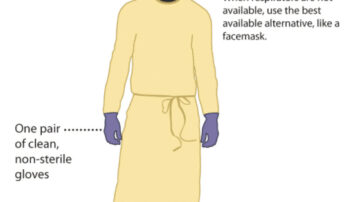The SARS-COV-2 pandemic started in January 2020 and has decimated the majority of U.S. hospitals for the past 18 months. The impact of COVID-19 has not only affected available hospital beds, but has limited the ability of hospitals to perform…
Read MoreA number of additional factors must be considered with airway management in COVID-positive patients. Hospital Procedures Consultants (HPC) can provide simulation-based training to prepare providers for airway management in COVID-positive patients. The first essential consideration is to place the patient into a…
Read MoreMore Articles – Featured, Hospital Procedures, Medical General, medical procedures, Respiratory diseases
Informed consent can be challenging during “normal” times, but it has become increasingly complicated during the COVID-19 pandemic. The informed consent process ensures that a patient or their surrogate decision-maker understands the benefits, potential risks and any alternatives of a…
Read MoreMore Articles – Cardiovascular diseases, Central line, Chest Tube, Endotracheal Intubation, Featured, Hematology, medical procedures, Thoracentesis
Traditionally, it was felt that the INR had to be less than 1.5 and platelets had to be at least 50,000/µL to perform most bedside procedures. With more clinical evidence, we now know that low-risk bedside procedures can be performed…
Read MoreOriginal studies of ultrasound-guided thoracentesis concluded a 2% risk of pneumothorax. A recent single center study of 9320 thoracenteses over 12 years all by procedural experts had pneumothorax rate of 0.6%. This same study also demonstrated a very low incidence…
Read MoreThe American College of Physicians (ACEP) has previously published guidelines in October 2013 about Procedural Sedation and Analgesia. In these guidelines, they provided Level B recommendations that state, “Do not delay procedural sedation in adults or pediatrics in the ED…
Read MoreContinuous Capnometry Should be Standard Practice for Moderate-Deep Procedural Sedation Continuous capnometry has been consistently proven to identify patients undergoing moderate-deep procedural sedation who have impaired ventilation well before hypoxia develops. There have been at least 8 studies that have…
Read MoreChest tube placement, or tube thoracostomy, can be an anxiety-provoking procedure for both the patient AND the operator. It can also be a very gratifying procedure for the operator when performed successfully and without patient discomfort. Here are a few…
Read MoreMore Articles – Cardiovascular diseases, Central line, Chest Tube, Featured, Infections, King Tube, medical procedures, Respiratory diseases, Thoracentesis
More Tags – chest tube, empyema, featured, HPC updates, parapneumonic effusion, pleural effusion, thoracentesis, tube thoracostomy
Complicated parapneumonic effusions frequently represent pleural space infections. Approximately 1 in 7 cases of pneumonia have an associated parapneumonic effusion (PPE) on chest x-ray. Most of these effusions are small and usually resolve spontaneously with prompt antibiotic administration. However, moderate-to-large…
Read MoreThe Society of Airway Management recently issued guidelines for Difficult Airway Management in COVID-19 patients. The SARS CoV-2 (COVID-19) virus is extremely contagious via respiratory droplets and therefore extra precautions are needed for airway management in severe COVID-19 infection. Airway…
Read MoreVideo laryngoscopy is superior to direct laryngoscopy for emergency intubations in the ICU. A recent meta-analysis based on nine trials evaluated 2,133 ICU patients and concluded that video laryngoscopy (VL) has a higher first pass success rate compared to direct…
Read MoreMore Tags – coagulopathy, epidural hematoma, featured, HPC updates, lumbar puncture, thrombocytopenia
A recent cohort study using the Danish nationwide medical registry demonstrates that the incidence of a spinal or epidural hematoma from lumbar punctures in patients with pre-existing thrombocytopenia (Platelets<150 K) or coagulopathy (INR>1.4 or aPTT>39 seconds) is not significantly higher…
Read MoreIntraosseous vascular access using the EZ-IO device is a wonderful option for emergency access in the hospital or pre-hospital setting. Intraosseous lines are easy to place with proper training and can serve as emergency vascular access during cardiac arrest or…
Read MoreIntraosseous line use has increased significantly since the advent of the battery powered intraosseous drill. In surveying providers at courses over the years, we have seen a steady rise in the number of providers with access to the intraosseous drill. …
Read MoreMore Tags – coagulopathy, epidural hematoma, featured, HPC updates, lumbar puncture, thrombocytopenia
Class 1 evidence to inform decisions about the safety of lumbar punctures in patients with a coagulopathy are lacking. The only guidance we have regarding the safety of lumbar punctures is based on clinical guidance from organizations such as the…
Read MoreCategories
- ACLS (1)
- Arterial line (33)
- Cardiovascular diseases (77)
- Central line (55)
- Chest Tube (39)
- Dermatology (4)
- Emergency Procedures (139)
- Endocrinology (6)
- Endotracheal Intubation (36)
- Events (24)
- FAST Exam (12)
- Featured (113)
- Featured Procedure (42)
- Gastrointestinal diseases (32)
- Ginecology (3)
- Glidescope Intubation (21)
- Hematology (33)
- Hospital Procedures (85)
- Infections (32)
- Intraosseous line (8)
- King Tube (27)
- Laryngeal Mask Airway (18)
- Lumbar Puncture (36)
- Mechanical Ventilation (34)
- Medical General (95)
- medical procedures (258)
- Needle Decompression (6)
- Nephrology (11)
- Neurological diseases (12)
- Oncology (4)
- Paracentesis (32)
- Pericardiocentesis (3)
- Procedural Sedation (19)
- Respiratory diseases (85)
- RUSH Exam (8)
- Thoracentesis (37)
- Traumatology (24)
- Travel (27)
- Ultrasound-Guided Peripheral IV (13)















